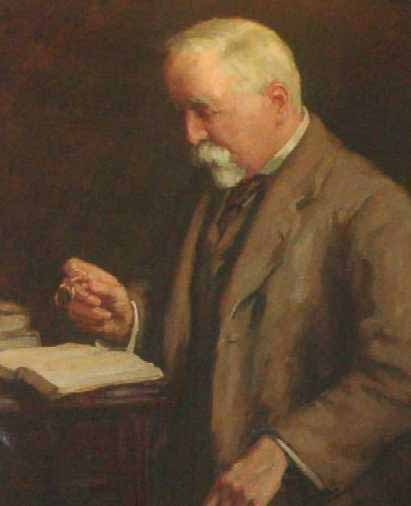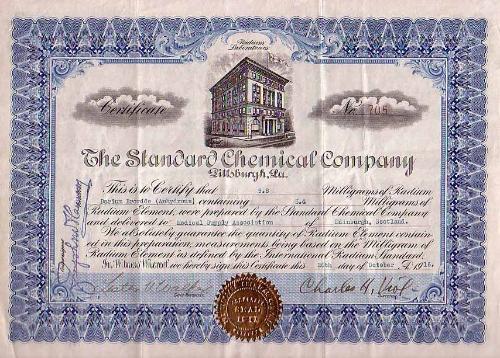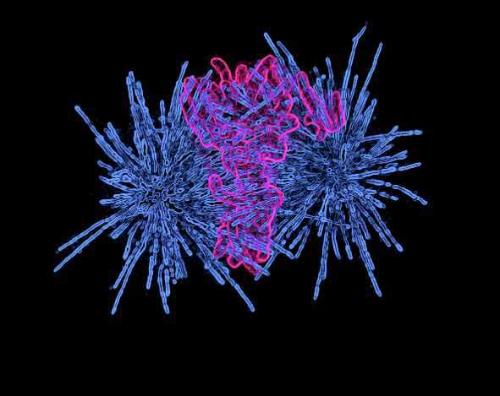Caird, Chemo & Caring
100 Years of Cancer Research in Dundee
An online version of the Tayside Medical History Museum exhibition
Originally staged at Ninewells Hospital, Dundee
December 2006 - June 2007

Plans of Caird Cancer Hospital by J Murray Robertson, courtesy of Dundee City Archives
100 years ago, in December 1906, the purpose-built Caird Cancer Hospital opened at Dundee Royal Infirmary. Today Dundee is a world leader in cancer research, and this exhibition charts the history of that extraordinary endeavour, and of the heroic fund-raising campaigns that have ensured its continuation.
The Origins of Cancer Research
Cancer has afflicted human beings throughout history. Some of the earliest evidence of the disease has been found in archaeological remains and ancient manuscripts. For example, the Edwin Smith papyrus, believed to have been written in Egypt in the 17th century BC, describes eight cases of tumours or ulcers of the breast that were treated by cauterisation with a tool called 'the fire drill'.
It was the ancient Greek physician Hippocrates who gave cancer its name, taken from the Greek word for a crab or crayfish. He was describing the pattern of the blood vessels over the surface of a breast cancer.
Another Greek physician, Galen, was the first to classify tumours into three headings - According to Nature (the gravid uterus), Exceeding Nature (benign tumours) and Contrary to Nature (cancer).
In the 18th century, the Italian Giovanni Morgagni pioneered the practice of autopsy to relate the patient's illness to the pathological findings after death. This laid the foundation for scientific oncology, the study of cancer.
Around the same time, the Scottish surgeon John Hunter suggested that some cancers might be cured by surgery and described how the surgeon might decide which cancers to operate on. If the tumour had not invaded nearby tissue, he believed "there is no impropriety in removing it." A century later the development of anaesthesia allowed surgery to flourish.
In Berlin in the 19th century, Rudolf Virchow provided the scientific basis for the modern pathological study of cancer, using a micro-scope to pioneer observations of cancer at a cellular level. He made many other crucial contributions, including the first description of leukaemia.
In the USA, William Stewart Halsted believed that removal of a cancer tumour would completely cure the patient, leading him to develop the radical mastectomy for breast cancer in the 1890s. This became the basis of cancer surgery for almost a century, until modern clinical trials showed that local removal of the primary tumour coupled with radiotherapy and chemotherapy is equally effective.
At the same time, the English surgeon Stephen Paget concluded that cancer cells spread via the bloodstream but could only grow in some organs. He compared the disease to seeds that "are carried in all directions, but they can only live and grow if they fall on congenial soil." Paget's conclusions were confirmed by the techniques of modern cellular and molecular biology almost a century later.

Accurate recording of cancer tumours developed during the 19th century. This diagram, showing cancer of the liver, was drawn by Neil Stewart in Edinburgh in the 1850s.
University of Dundee Archive Services, MS 16/12.
The Caird Cancer Hospital

This portrait of Sir James Caird by David Foggie hung in Dundee Royal Infirmary for many years, and is now part of the Medical History Museum collection. Foggie painted a copy of the portrait to hang in Caird Hall, where it can still be seen today.
In 1902 the Dundee manufacturer James Caird, owner of two leading jute mills, Craigie Works and Ashton Works, offered £18,500 to the directors of Dundee Royal Infirmary to erect a hospital for the treatment of cancer, and also provided £1,000 a year for five years to fund research "into the nature of this mysterious disease."
Plans were drawn up by architect J Murray Robertson in 1903 but the building was only finally completed three years later. It was officially opened on 17 December 1906, with the first patients admitted in January 1907.
The building comprised six isolated wards, one of which was designated as an Electrical Ward for the treating of cancer using electricity. There were also two operating theatres whose equipment was at that time thought to be unrivalled anywhere in Scotland.
Since only three of the wards were immediately occupied with cancer patients, other parts of the building were used to relieve overcrowding in the main hospital. The Electrical Ward was used to treat not only cancer but also a variety of skin diseases.
In February 1908 Dr Archibald Leitch from Rothesay was appointed as Investigator in Cancer Research, having previously worked in the cancer research laboratories of Middlesex Hospital. A year on, the DRI Annual Report noted: "the reports which he has submitted to Mr Caird and the Directors indicate a wide field which has to be gone over, and the difficulties which have to be overcome before a definite statement may be made as to the nature of the disease."
Over the next few years Leitch published his researches in various medical journals including The Lancet and the Proceedings of the Royal Society of Medicine. He also regularly exhibited specimens in the DRI museum to be examined by students and visiting researchers. Sadly, no further funding could be found after Caird's five year bequest ran out, and in 1912 Leitch moved to London. Although DRI continued to maintain dedicated cancer wards, the Caird Hospital soon ceased to specialise and was later used for general surgery, orthopaedic surgery and paediatrics.
Two years after Caird announced his generous gift, ex-Provost A H Moncur offered £5,500 for the erection and equipping of a new cancer ward at Royal Victoria Hospital. Opened in 1906, it provided 20 additional beds, but there were no extra funds for research.
The number of deaths from cancer increased notably in the 1920s, and the Royal Infirmary became more active in fund-raising appeals to increase supplies of radium and other treatments. Research, however, was more sporadic. In 1931 Dundee hosted a major conference organised by the National Smoke Abatement Society, at which Dr Elizabeth Mudie provided clear evidence to link certain cancers with smoke in the air. In 1933 further research work was aided by a bequest of £4,492 from the late Helen Rodger of Inverkeilor.
These pioneering researchers were full of optimism. In 1939 the medical superintendent of Dundee Royal Infirmary, Dr H J C Gibson, claimed that the rate of progress in medical science had been so great that diseases like cancer were "almost curable".
Radium in Dundee
Radium was first used to treat cancer in Dundee in 1913, when 20 milligrams was ordered thanks to donations by James Caird and the Sharp family. The DRI's next annual report report stated: "The radium gifted last year has been in almost daily use, and while in certain cases undoubted cures have been effected, the Medical Officers have felt the comparatively small quantity available to be a decided disadvantage in this method of the treatment of cancer. It is hoped that during the ensuing year the resources of the Hospital in this respect may be increased".
Further deliveries of radium followed, the results proving so successful that in 1919 an additional 100mg was requested at a cost of £1,350, the Directors hoping that the cost "may be met by special donations".
In order to ensure the availability of radium for treatment, and also to encourage research into its use, a National Radium Commission was set up in 1929. National Radium Centres were set up in various cities around the UK, including Dundee.

Radium Certificate for DRI, 1916. Tayside Medical History Museum
Treatment: Radium & Radiotherapy
After Marie Curie had accidentally burned herself carrying a phial of radium in her pocket, she noticed that healthy skin formed rather than scar tissue. She and her husband Pierre thus realised that radium might be of use in the treatment of cancer. In 1904 it was proved that radium rays killed diseased cells preferentially, and within the next ten years radium institutes opened across Europe.
Radium could be applied close to the body (surface therapy), inserted into body cavities (intracavitary therapy) or, when enclosed in sealed tubes or needles, be inserted directly into the tissues (interstitial therapy).
By the 1950s, radium was being replaced by artificial radio-isotopes such as iridium, cobalt and iodine. Eventually it was abandoned completely, mainly because of the difficulties of protecting against the side-effects of its radioactive properties. Over a period of some 80 years, however, many thousands of people across the world had been cured by this element.
The years following World War I witnessed growing interest in the use of radium treatment, but also extravagant claims for the supposed health benefits of radium. These advertisements are typical of the time. Radium toothpaste, radium hair tonic and even radium drinking water were readily available.
Radiation therapy began with radium and with relatively low-voltage diagnostic machines. A major breakthrough took place when it was discovered that daily doses of radiation over several weeks would greatly improve therapeutic response. The methods and the machines for delivery of radiation therapy have steadily improved. Today radiation is delivered with great precision in order to destroy malignant tumours while minimising damage to adjacent normal tissue.
Treatment: Chemotherapy
The discovery of drugs to treat cancer was a direct result of the use of mustard gas in World War I. German studies on the victims of mustard gas poisoning showed that white blood cell counts were reduced - consistent with a toxic effect on dividing cells. This observation led to the synthesis and investigation of nitrogen mustards as agents to treat cancer.
The chemical weapons programmes undertaken in the USA during World War II produced other useful compounds. One revealing incident occurred in 1943 when Germans bombed American munition and supply ships off the Italian coast at Bari. The survivors who were pulled from the water smelt strongly of garlic (the characteristic odour of mustard gas). Many of these men died later from marrow failure, due to the cytotoxic activity of the gas.
The first real cure with chemotherapy took place in the USA in 1956 when Min Chiu Li and Roy Hertz used methotrexate to treat a 24 year old woman suffering from widespread choriocarcinoma. She was discharged with no further traces of the disease just four months later.
In the last 50 years numerous chemotherapy drugs have been developed which can successfully treat cancer. Acute childhood leukaemia, testicular cancer and Hodgkin's disease can now be completely cured, while other forms of cancer can be controlled for long periods of time. Clinical trials to develop new drugs are ongoing throughout the world, and Dundee plays a major part in this.
Current Cancer Research in Dundee
Dundee is now a world leader in cancer research, with hundreds of dedicated staff based at the University of Dundee and Ninewells Hospital. 19 research groups have come together to form the Dundee Cancer Research UK Co-operative Centre. Their current research interests include:
- Investigating how cells multiply
- Unravelling the role of the p53 gene
- Understanding how the APC gene protects us against bowel cancer
- Identifying factors that influence our response to anti-cancer drugs
- Understanding how acute promyelocytic leukaemia develops
Boasting one of the UK's leading art colleges, Dundee is well placed to create some extraordinary collaborations between art and science. Find out more about this work here.

This microscopic image shows the mitotic spindle (blue) and chromosomes (pink) from a kidney cancer cell. The chromosome on the right has failed to join the others in the middle.
Courtesy of Dr Paul Andrews, Wellcome Trust Biocentre
Fundraising
The Imperial Cancer Research Fund (ICRF) was founded in 1902 by the Royal Colleges of Physicians and Surgeons who were concerned about the level of human suffering caused by cancer. A group of ICRF scientists and doctors decided they wanted to focus more heavily on clinical research, and in 1923 they founded the British Empire Cancer Campaign (BECC) "to attack and defeat the disease of cancer in all its forms, to investigate its causes, distribution, symptoms, pathology and treatment and to promote its cure".
In 1970 BECC changed its title to Cancer Research Campaign, and in 2002 the two bodies re-merged to become Cancer Research UK, the world's largest independent organisation dedicated to cancer research. Cancer Research UK currently supports the work of 19 groups that make up the Dundee Cancer Research UK Co-operative Centre, formed in 2002 to maximise scientific collaboration and further develop Dundee as a centre for excellence in cancer research. This work is also supported by many other charities - local, national and international - and Dundee's cancer researchers are grateful to all of them for their generous support.

The Ninewells Cancer Campaign was started in 1991 with the aim of establishing and maintaining Dundee as a world-leading Centre of Excellence in cancer research and the development of new and better treatments for patients with cancer. To date an amazing £16 million has been raised by the people of Tayside and Fife - well done!
Dennis the Menace is still fighting - and there is still lots to do! Current campaigning is focused on raising £1.5 million for 'personalised medicine', where the aim is to tailor treatment to the individual. We hope that you will visit and enjoy the exhibition - and perhaps it will encourage you to continue the fantastic public support for local medical research.